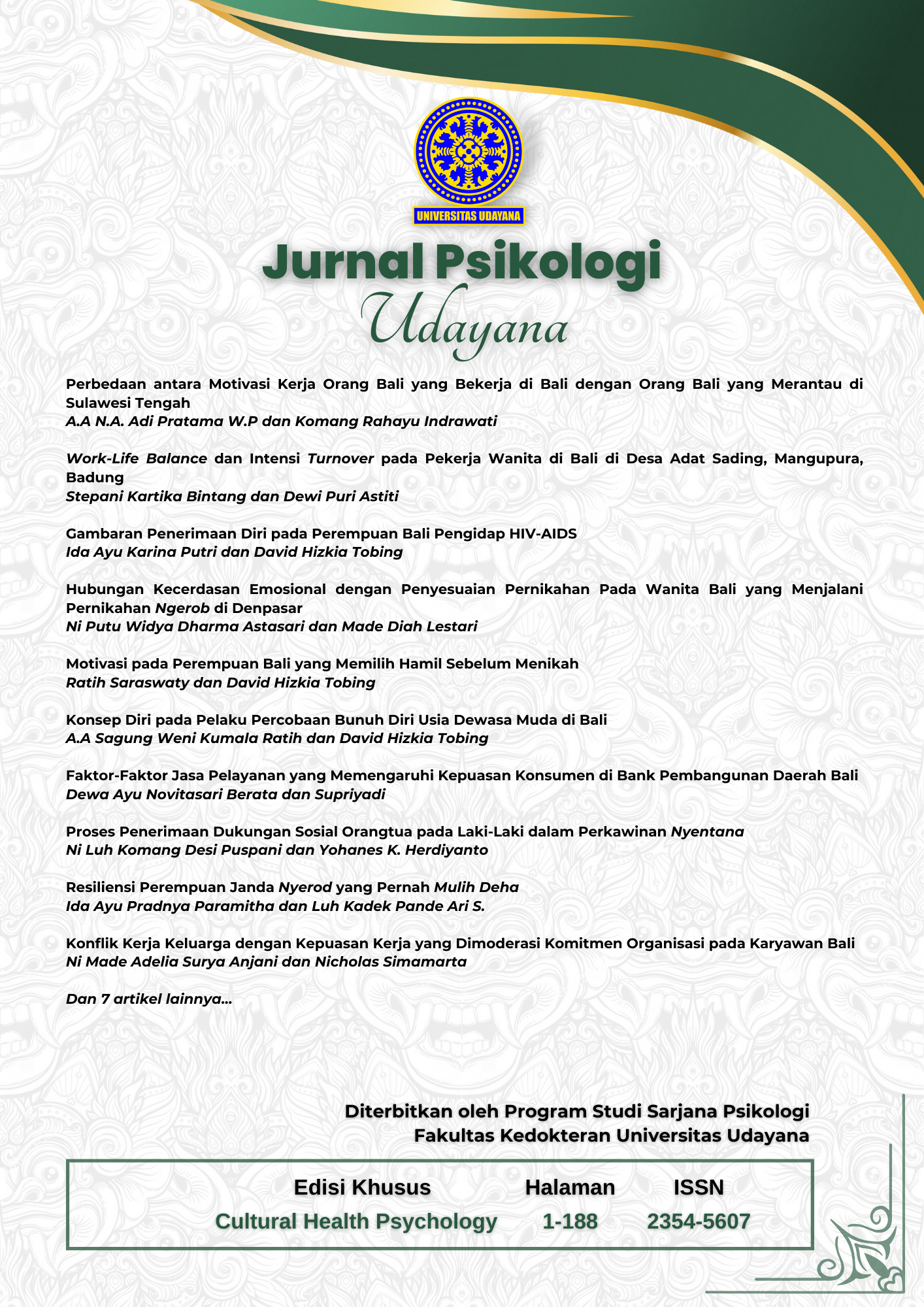Peran Perilaku Prososial, Efikasi Diri dan Empati pada Pegawai Badan Penanggulangan Bencana Daerah (BPBD) di Bali
Abstract
Prosocial Behavior is a term of aid behavior which intended to assist people. Prosocial Behavior is an obligation and the main duties of BPBD employee; as it is known that BPBD is enganged in disaster management that emphasizes the humanitarian aspects on the duties or occupation which have been stated in Undang-Undang No 24 Tahun 2007. In carrying out the duties which full of risks and challenges, the employees are required to have the confidence for implementing the capabilities. Furthermore, prosocial behavior is influenced by the empathy to strengthen the help behavior. The research was intended to know the contribution of prosocial behavior, self-efficacy, and empathy in the employee of BPBD in Bali.
The subjects of the research were 96 persons; the employees' status are civil servant in BPBD. The research used quantitative approach; in addition, the research instruments were the prosocial behavior scale, self-efficacy scale, and the empathy scale. The analytical method used mutiple regression. R square was 0.414, it was that mean 41% of prosocial behavior can be explained by self-efficacy and empathy. In the regression of t test, it found that standardized empathy coefficient was 0.420. Therefore, the empathy was an independent variable that has the biggest contribution toward prosocial behavior by 42% compared to the contribution of self-efficacy by 31%
Keywords: prosocial behavior, self-efficacy, empathy, the employee of BPBD.
Downloads
References
Asih, G. Y., & Pratiwi, M. S. (2010). Perilaku prososial ditinjau dari empati dan kematangan emosi. Jurnal Psikologi Sosial, 1 (1), 1-10.
Ardhiangga. (31 Januari 2015). Longsor di Karangasem, 2 orang meninggal dunia. Dipetik Februari 26, 2015, dari news.detik: darihttp://news.detik.com/read/2015/01/31/223937/2820140/10/longsor-di-karangasem-2-orang-meninggal-dunia
Ardiansyah, J. (24 Juni 2015). Pasifik ring of fire dan bencana tsunami. Dipetik September, 11, 2015, dari kompasiana: http://www.kompasiana.com/ardiansyah_jasman/pasific-ring-of-fire-dan-bencana-tsunami
Azwar, S. (2013). Penyusunan skala psikologi (2nd ed.). Yogyakarta: Pustaka Pelajar.
Bandura, A. (1997). Self-efficacy: the exercise of control. New York: Freeman.
Baron, R. A., & Byrne, D. (1984). Social psychology: understanding human interaction. New York: Allyn and Bacon.
Baron, R. A., & Byrne, D. (1991). Social psychology undersranding human interaction. Boston: Allyn and Bacon.
Baron, R. A., & Byrne, D. (2005). Psikologi sosial. (Kristiaji & Medya. Jakarta : Erlangga).
Benny, N. J. (28 November 2010). Indonesia bisa alami 8.000 kali gempa. Dipetik Agustus 12, 2015 dari regional.kompas: http://regional.kompas.com/read/2010/11/28
Brigham, J. C. (1991). Social psychology. New York: Harper Colling Publisher Inc.
Dayakisni, T., & Hudaniah. ( 2006 ). Psikologi sosial. Malang: Universitas Muhammadiyah Malang.
Eisenberg, N., & Mussen, P. H. (1989). The roots of prosocial behavior in chidren. University Of Cambridge.
Feist, J., & Feist, G.J. (2010). Teori kepribadian (7 ed.). (R. Oktafiani, Penyunt., & S. P. Sjahputri, Penerj.) Jakarta: Salemba Humanika.
Gerungan. (2002). Psikologi sosial. Bandung: Refika Aditama.
Goleman, D. (2001). Kecerdasan emosional: mengapa EI lebih penting daripada IQ. Jakarta : Gramedia.
Ghozali, I. (2011). Aplikasi analisis multivariate dengan program IBM SPSS 20. Semarang: Badan Penerbit Universitas Diponegoro.
Ghufron, M. N., & Risnawita, R. (2014). Teori-teori psikologi. Jogjakarta: Ar-Ruzz Media.
Papalia, D. E., Oldss, S. W., & Feldman, R. D. (2008). Human development: perkembangan manusia. Jakarta: Salemba Humanika.
Peratura Kepala BNPB Nomor 3 Tahun 2008 tentang Pedoman Pembentukan Badan Penanggulangan Bencana Daerah.
Prosedur Tetap (PROTAP) Tanggap Darurat Bencana. Bangli: Badan Penanggulangan Bencana Daerah (BPBD) Kabupaten Bangli Tahun 2014
Purwanto. (2007). Metode penelitian kuantitatif. Surakarta: Pustaka Pelajar.
Rachmad. (23 Februari 2012). Tragedi Tsunami Aceh paling hebat di dunia pada abad ke-21. Dipetik April 2, 2015, dari sosbud.kompasiana: http://sosbud.kompasiana.com/2012/02/23/tragedi-tsunami-aceh-paling-hebat-di-dunia-pada-abad-ke-21-441847.
Santoso, S. (2014). Statistik parametrik: konsep dan aplikasi dengan SPSS. Jakarta: Gramedia.
Sirapati, F.I. (2015). Kinerja Badan Penanggulangan Bencana Daerah (BPBD) dalam menanggulangi bencana banjir di kampong Lambing Kecamatan Mutiara Lawa Kabupaten Kutai Barat. Ejournal Ilmu Administrasi Negara. 3 (3), 1-14.
Siregar, S. (2014). Peta tematik potensi desa 2014 Provinsi Bali. Denpasar: BPS Provinsi Bali.
Slavin,R.E. (2008). Psikologi pendidikan: teori dan praktik. Jakarta: Indeks.
Spica, B. (2008). Perilaku prososial mahasiswa ditinjau dari empati dan dukungan sosial teman sebaya. Skripsi, 32-65.
Supanto. (2007). Perilaku prososial ditinjau dari gaya kelekatan dan efikasi diri: pada siswa SMP di wilayah Kabupaten Sleman Daerah Istimewa Yogyakarta. Tesis (tidak dipublikasikan). Universitas Gajah Mada, Yogyakarta.
Taylor, S. E., Peplau, L.A., & Sears, D. O. (2009). Psikologi sosial (12 ed.). Jakarta: Kencana.
Taufik. (2012). Empati, pendekatan psikologi sosial. Jakarta: Rajawali Persada.
Undang-Undang Republik Indonesia Nomor 24 tahun 2007 Tentang Penanggulangan Bencana.
Wicaksono,W., Usdianto,B., Hoppe, M. (2010, Agustus 30). Berbagi pengalaman membentuk Badan Penanggulangan Bencana Daerah di daerah percontohan. Dipetik September 2015, 21 dari German Indonesian Tsunami Early Warning System: http//www.gitews.org/tsunami/kit.pdf.
Authors who publish with this journal agree to the following terms:
- Authors retain copyright and grant the journal right of first publication with the work simultaneously licensed under a Creative Commons Attribution-ShareAlike 4.0 International License that allows others to share the work with an acknowledgement of the works authorship and initial publication in this journal.
- Authors are able to enter into separate, additional contractual arrangements for the non-exclusive distribution of the journals published version of the work (e.g., post it to an institutional repository or publish it in a book), with an acknowledgement of its initial publication in this journal.
- Authors are permitted and encouraged to post their work online (e.g., in institutional repositories or on their website) prior to and during the submission process, as it can lead to productive exchanges, as well as earlier and greater citation of published work (See The Effect of Open Access).













